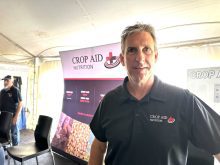Blake Matthews works closely with agronomist Jared Cook on an intensive cropping program that improves plant health and soil health, reduces pesticide use and somewhat increases profits. Here we take a look at Matthews’ program and Cook’s core principles. Then we check in with Canadian experts to see how these principles could work on the Prairies.
Idaho potato farmer Blake Matthews caught the attention of Nature United with his crop-nutrition-first approach to pest management.
Matthews grows 3,000 acres of irrigated annual crops, including 400 to 500 acres of potatoes, the same in sugar beets, and the rest split among corn, barley and wheat. Over the past five-plus years, the farm applied one in-season fungicide to potatoes and only last year applied localized spray for insects — specifically, grasshoppers.
Read Also

Hemp’s future hinges on honest agronomy, experts say
Years of hype have given way to a more realistic view of hemp. Canadian farmers and processors say its future depends on solid agronomy and honest messaging.
This minimal pesticide requirement may sound unbelievable, especially to other potato growers. “We do make some big claims,” Matthews says.
In addition to lowering pesticide use and synthetic fertilizer use, Matthews also says soil organic matter across the farm is in the three to four per cent range, up from a range from 0.7 to two before he put the focus on soil health and plant nutrition.

These numbers, in turn, caught the attention of Brad Johnson, Idaho agriculture strategy manager for Nature United (called The Nature Conservancy in the U.S.). Johnson says the non-government organization’s goal is to help modern agriculture become more sustainable. “We want to keep all tools, but seek judicious respectful use of pesticide products,” Johnson says.
Matthews Land and Cattle is one of Johnson’s demonstration farms.
Potatoes are an input-intensive crop, Johnson says. Potato crops often get soil fumigation for nematodes, along with fungicides and insecticides throughout the growing season. Matthews has all but eliminated these applications, Johnson says.
What’s more, Johnson adds, Matthews has also reduced tillage from four or five passes down to two passes, and reduced overall water use by 18 to 20 per cent.
Matthews “lets biology run the system,” Johnson says.
The core of the system is a soil health plan from long-time local agronomist Jared Cook. “Diseases and insects attack weak plants,” says Cook, agronomic specialist and sales consultant with Rocky Mountain Agronomics in Idaho. “And weakness is often related to nutrition.”
Cook has been working with Matthews and his family business, Matthews Land and Cattle, for 14 years. A key part of the soil health plan is manure compost from dairies and cattle feedlots, which improves organic matter and reduces the need for other fertilizer sources. Cook also prescribes two broad-spectrum hormones, which he won’t share because they are, he says, part of his competitive advantage.
For nutrients, Cook wants balance. He doesn’t want nitrogen availability to get ahead of the other nutrients. “In that situation, nitrogen robs yield,” he says. (Later in this article, Western Canadian crop nutrition experts comment that this can be true for potatoes and wheat, but perhaps not canola.)
“My game is to prioritize mineral nutrition, then use hormones to drive greater response,” Cook says.
The author told Cook during their interview that he usually looks at hormones and biologicals with a degree of skepticism. Cook supports that skepticism. “My approach has changed,” he says. “Ten years ago we didn’t have as many players in this space and I had almost complete trust. Now growers need a trusted advisory team.”
Cook emphasizes his methodical approach to nutrient decisions for all crops, using weekly and biweekly plant sap analysis of new and old leaves in combination with rapid soil testing. For Matthews, his in-season top-ups run through the irrigation system while watering.
With traditional tissue tests taken from new growth only, “you actually never know where the nutrient is coming from,” Cook says. “It could and should be from roots like normal or it could be from old leaves, where mobile nutrients are leaving the old growth to support new growth. We know yield is optimized when you can hold the plants’ old growth and new growth leaf nutrient density to a tight tolerance between them.”
Without accurate diagnosis, input use is “a guessing game and we just don’t need to be guessing,” Cook says. “These new advances in plant testing methods give us the edge in making the right decisions.”

Of course the final question is: does this intense level of management pay?
“We haven’t seen anything really for a yield change. We have, however, seen our quality go up in many different aspects,” Matthews says. “As far as the spend goes, for the most part, we’ve just traded dollars. We’ve replaced fertility with the compost, and replaced fungicides, insecticides and fumigants with nutritionals and biologicals. Overall, though, we probably save about $100 per acre from what our old program used to be.”
Reaching out to Prairie expertise
For many farms, ideal fertilizer management is simple: use soil tests to identify the right rate based on the farm’s yield target. Then choose nutrient sources that meet crop needs at the lowest cost and the greatest logistical efficiency. Manure can be a great nutrient source and organic matter booster when available and when applied based on nutrient analysis.
With these basics established, farms could dig deeper — in the way Matthews has — and hire an experienced agronomist to develop a more comprehensive plan.
Jared Cook outlines the four practices at the heart of his program:
- Balanced nutrition can make plants more resilient to insects and disease, and reduce the need for fungicides and insecticides.
- If farms put the primary focus on higher nitrogen rates, that extra nitrogen — when other nutrients are out of balance — can actually rob yields.
- Plants with correct nutrition have higher sugars (brix) and more secondary metabolites – compounds plants use to defend themselves.
- There are 16 essential elements, each with a specific mode of action. We need to pay closer attention to micros.
Do those four practices work for the common crops and farm systems in Western Canada? We polled western Canadian specialists — crop nutrition researchers, experienced agronomists and plant physiologists — to see what they thought of Cook’s four practices.
Balanced nutrition can make plants more resilient to insects and disease, and reduce the need for fungicides and insecticides. Is this true?
“It’s true, a crop with balanced nutrients can better tackle diseases and insects,” says Raju Soolanayakanahally, a plant physiologist with Agriculture and Agri-Food Canada in Saskatoon. “Balanced nutrients permit vigorous growth, thus providing active immunity as a result of increase phytonutrient, protein and lipid synthesis. Apart, photosynthesis will operate at its peak under balanced nutrition and adequate soil moisture. So if pests attack the plant, the plant can divert resources to tackle biotic stress without compromising yields.”
In general, experts agree healthy plants will be hardier plants. However, that does not mean healthy plants are immune to disease.
“Higher fertility leads to more vegetative growth, and lush canopies create a microclimate conducive for higher disease severity,” says Mike Harding, crop assurance lead for Alberta Agriculture and Irrigation. “In many cases the conditions for maximum plant growth are also the conditions for maximum disease potential.”
Chris Manchur, agronomy specialist with the Canola Council of Canada, adds, “We all know sclerotinia risk is higher in high-fertility environments.”
Jason Voogt says crop resilience to disease or insect pressure has “more to do with genetics.” The owner and lead agronomist with Field 2 Field Agronomy at Miami, Man. gives an example: “We had 200-bu./ac. oat crops in 2024. I would say those oats didn’t lack anything, yet we would have had major losses to crown rust had we not sprayed a fungicide this year.”
Ross McKenzie, retired agronomy research scientist with Alberta Agriculture, agrees nutrition is one path but not the only path to hardier plants. “A number of good agronomic factors, including soil fertility and fertilizer management, increase crop health, improve yield potential and help to reduce the impacts of diseases and/or insect pressure,” he says. “Probably the most notable is earlier seeding and slightly higher seeding rates.”

Lyle Cowell, Nutrien senior agronomist based at Tisdale, Sask., can cite many studies showing how specific nutrient deficiencies can increase specific diseases in specific crops. For example, “early examples showed that phosphorus deficiency leads to increased seedling rot due to pythium,” he says, citing a 1935 journal article by T.C. Vanterpool in the Canadian Journal of Research.
However, adding a nutrient to a crop that is not deficient will not “cure” a disease, he says. “For example it has often been suggested that copper will reduce ergot in wheat, but this is only true if the wheat is deficient in copper.”
If farms put the primary focus on higher nitrogen rates, that extra nitrogen — when other nutrients are out of balance — can actually rob yields. Is this true?
“I do not believe this for canola,” says Mario Tenuta, research chair in 4R Nutrient Stewardship at the University of Manitoba. He does believe it for other crops, giving two examples: wheat can lodge with excess nitrogen, and potatoes can have excess vine growth — two things that could, in theory, increase disease.
“I don’t believe this, except in the extreme, like where nitrogen levels become so high that they are toxic,” says Harding. “Studies I’m familiar with show that excess nitrogen is not advantageous or detrimental to yield. I do believe that excess nitrogen is a waste of money, so it will rob profit, but not yield. It is also possible that the lack of other nutrients may rob yield, but excess nitrogen will not.”
Others, including Cindy Grant, were believers. A retired research scientist with Agriculture and Agri-Food Canada at Brandon, Man., Grant says yield can decrease if growers add excess nitrogen without a balanced supply of other nutrients.
“Years ago, when I was a student and before it was widely recognized that our soils would be deficient in sulphur for canola, my husband-to-be had severe sulphur deficiency on his canola field,” Grant says. “It ended up getting every disease you could think of because the deficiency weakened it. I had one trial where every treatment that I used to improve nitrogen efficiency decreased canola yield because of an nitrogen:sulphur imbalance.”
Plants with correct nutrition have higher sugars (brix) and more secondary metabolites — compounds plants use to defend themselves. Is this true?
This one left most of our experts scratching, especially with regard to brix — a measure of plant sugars often used to assess grape sugar content when making wine. Higher brix means potentially higher alcohol content in the wine.
Cowell says brix is becoming a bit of a hot topic. “I have oddly been asked about brix many times this winter,” he says, “and my reply has been the same. If you grow wine and want to harvest for best sugar content, then brix is a tool to use. Otherwise, where is the data?”
Tenuta has a similar thought: “If brix was so useful, we’d be all be using it like a soil test.” He did, however, agree that good plant nutrition can lead to secondary metabolites useful in plant defence.
Xiaopeng Gao, associate professor of soil fertility and agronomy at the University of Manitoba, says “proper nutrient supply can improve plants’ photosynthesis efficiency, producing more sugars and secondary metabolites such as flavonoids, alkaloids and phenols. These compounds can help plants against attacks from pathogens and pests. Additionally, some compounds such as flavonoids can improve plants’ antioxidant properties, and therefore increase tolerance to abiotic stresses such as heat and drought.”
Soolanayakanahally agrees. “Higher secondary metabolites can impart better defence against pest and disease.”
There are 16 essential elements, each with a specific mode of action. We need to pay closer attention to micros. Is this true?
The experts generally agreed with this.
“I believe there is a growing need to pay attention to micros across Prairies,” Gao says. His reasons: one, canola, soybeans and corn have high requirements for micros and their acres, in total, are increasing. Two, fewer mixed farms mean lower use of livestock manure. And three, we are paying more attention to the importance of micros (for examples, iron and zinc) for human health.
Cowell says pay closer attention to micronutrients only if you need them. “The idea that micronutrient deficiencies are ‘hidden’ is a fallacy — these deficiencies tend to lead to yields falling off a cliff,” he says. He sees zinc applied to soils with no need for extra zinc and while he has seen boron deficiencies, it was “only on terrible soils that no one should farm.” Cowell’s conclusion: “Beyond that, this becomes a wasteland of marketing and improper sales.”
MORE ON MICROS: Soil fertility, revisited
Harding says manganese and zinc are “often heralded as having disease-reducing properties.” He also says boron availability is connected with clubroot infection in canola, and chloride deficiency can “predispose some crops to certain infections or physiological issues” — but again, only if they’re short.
Harding puts this whole conversation in perspective: while macronutrient and micronutrient fertility is a “critical agronomic principle necessary to allow the crop to reach its genetic potential, it is probably only occasionally a significant modulator of disease,” he says. “It is never as impactful as primary disease management principles like genetic resistance, crop rotation, clean seed and fungicides.”
The take-away
How do farmers use this information?
We interviewed a venture capital investor recently who encourages Canadian agriculture to at least pay attention to those voices at the fringe of common practice. Those may be the people who bring forth revolutionary ideas to make farming more efficient, more productive and more profitable.
In many cases, though, farms can advance all three of these by exploring the practices we already know.
Whether leaning into what we know or exploring the new and untested, it helps to have help. Get sound advice from an experienced agronomist. And listen to that little voice in your ahead that wonders, ‘Can this be right?’
“As we’ve gone down this road, the No. 1 skeptic has been my dad,” Matthews says.
What the family discovered together is that “the old days of strictly managing nitrogen, phosphorus and potassium are gone,” Matthews says. And from that point, their work with Cook has shown “plants in balance will have lower pest management costs.”
While we do not have much crop data to support this claim on the Prairies, the logic in those two broad statements is sound — as our experts have shown. How farmers achieve that “balance” is still open to debate. But if we are to make the efficiency gains we need to make, these are discoveries worth making.
















